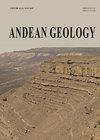南美洲最南端阿根廷安第斯山脉西部冰斗的形态计量和空间分布
IF 1.2
4区 地球科学
Q3 GEOLOGY
引用次数: 6
摘要
冰川旋涡是高山景观中一个独特的浮雕元素,它们的形态、分布和空间排列通常与形态气候因素有关。本研究分析了阿根廷南部安第斯山脉西南部一个选定的高山型地区251个一级马戏团和99个“内部”马戏团的形态特征、地板高度、外貌和分布。从卫星图像和数字高程模型中提取和量化参数变量,并将其集成到地理信息系统中进行系统化和处理。在评估的不同几何和空间参数之间发现了显著的关联。研究区环形地貌的变化表明,它们的演化在很大程度上受到与比格尔古冰川活动有关的冰川动力学和山剖面的东西地形梯度的调节。记录表明,在富吉安地斯山脉,大多数冰环在三维上经历了异速扩张(即,与墙的水平扩张相比,垂直侵蚀较小),其大小和形状的局部变化受冰停留时间、方向和高度的控制,而地质构造应该影响整个山脉的冰环形成。在其发展过程中,环形方位角可能受到气候(太阳辐射和西风)、构造(普遍断层和岩层)和地形的综合影响。特别是,东南方向的优势被解释为该地区过去冰期相对无云的大气和干旱的结果,这与已发表的证据一致。在不同强度的连续冷期中,环流底高度没有与纬度相关的变化被认为表明该地区发生了广泛的冰川作用(即,主要是冰盖条件,山峰远高于区域平衡线高度或ELA),以及形成了更年轻、更低的环流。在较大的(先前存在的)旋流中出现“内部”旋流被认为反映了ELA的临时位置恰好位于容器旋流的底部上方,允许短暂的小型旋流型冰川沿着构造基岩弱点发育。本文章由计算机程序翻译,如有差异,请以英文原文为准。
Morphometry and spatial distribution of glacial cirques in the Western Fuegian Andes of Argentina, southernmost South America
Glacial cirques comprise a distinctive element of relief in alpine landscapes, and their morphometry, distribution and spatial arrangement are generally linked to morphoclimatic factors. This study provides an analysis of morphometric characteristics, floor altitude, aspect and distribution of 251 first-order and 99 "inner" cirques with regard to environmental agents in a selected alpine-type area of the southwestern Fuegian Andes, in Southern Argentina. Parametric variables were extracted and quantified from satellite images and a Digital Elevation Model, and integrated to a Geographical Information System for their systematization and processing. Significant associations were identified between the different geometric and spatial parameters evaluated. Variability in cirque morphometry along the study area suggests that their evolution was regulated to a large degree by glacial dynamics related to Beagle palaeoglacier activity, and by the W-E topographic gradient of the mountain section. The record indicates that most cirques in the Fuegian Andes have undergone allometric enlargement in the three dimensions (i.e., lesser vertical erosion compared to walls' horizontal expansion), with local variations in size and shape controlled by ice residence time, aspect and altitude, whereas geological structure is supposed to have affected cirque formation along the entire mountain chain. Cirque azimuth potentially responds to the combined influence of climate (solar radiation and westerly winds), structure (pervasive faulting and rock bedding) and topography in their development. In particular, dominance of southeasterly aspects is interpreted as a consequence of a relatively cloud-free atmosphere and aridity during past glacial periods in the region, consistently with published evidence. The absence of aspect-related variation in cirque floor altitude is considered to indicate incidence of extensive glaciations in the area (i.e., mostly ice-sheet conditions, with mountain peaks far above the regional equilibrium line altitude or ELA), as well as formation of younger, lower cirques during successive cold periods of different intensity. Occurrence of "inner" cirques inside larger (preexisting) cirques is thought to reflect a temporary positioning of the ELA just above the floor of the container cirque, permitting short-lived, small cirque-type glaciers to develop along structural bedrock weaknesses.
求助全文
通过发布文献求助,成功后即可免费获取论文全文。
去求助
来源期刊

Andean Geology
地学-地质学
CiteScore
3.90
自引率
0.00%
发文量
17
审稿时长
>12 weeks
期刊介绍:
This journal publishes original and review articles on geology and related sciences, in Spanish or English, in three issues a year (January, May and September). Articles or notes on major topics of broad interest in Earth Sciences dealing with the geology of South and Central America and Antarctica, and particularly of the Andes, are welcomed.
The journal is interested in publishing thematic sets of papers and accepts articles dealing with systematic Paleontology only if their main focus is the chronostratigraphical, paleoecological and/or paleogeographical importance of the taxa described therein.
 求助内容:
求助内容: 应助结果提醒方式:
应助结果提醒方式:


